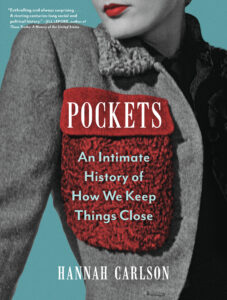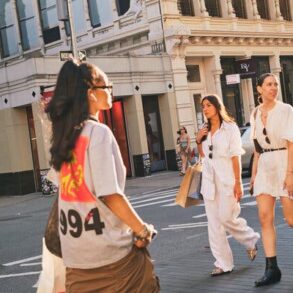The early nineteenth-century press offered readers dismissive accounts of new fashions, specifically scolding women for their “silliness” in acquiescing to “the very inconvenient custom of being without pockets.” Women were more willing to relinquish their free agency as consumers than to challenge fashion, so the charge went. Reporting on the tribulations of one such follower of fashion in 1806, the Weekly Visitor ran a story about a young woman intrigued by the sight of a peddler’s wares. She was hoping to make a purchase but had to admit she couldn’t because she didn’t have any money. The reason? She hadn’t worn a pocket. Desperate for a customer, the peddler was forced to follow the unprepared woman home to collect his payment. A 1789 sketch was less indulgent and forgiving in tone. Titled Fashionable Convenience!!, it depicts a young child asking for money to buy cakes. Mamma replies, “How can you be so vulgar, child, have not I told you a hundred times I never wear pockets!” Women conformed to fashion’s dictates at the expense of convenience, sacrificing even those little but meaningful things like treating their youngsters to sweets.
The mockery got no better for women when they sought a practical alternative in reticules. In carrying reticules, women were essentially exposing their pockets, a once-private accessory. Pockets were previously classified as undergarments, so these displays were an unseemly spectacle to many. An illustration from 1800 makes that connection apparent while ridiculing women for their impractical dress choices. Fashionable ladies are shown in their winter dress wearing floral hats that impede their sight, transparent dresses that show off their nakedness and hardly protect from the cold, and reticules that swing lower and lower down their stockingless legs. The English promptly chose to mispronounce the French word for the fashion accessory and referred to it as a “ridicule,” or, perhaps further punning on its tiny, impractical size, an “indispensable.”
Tie-on pockets came to be associated with the habits of more traditional women, industrious housewives, and “old ladies.” In them housewives carried everything they needed. They were an “honest” and useful receptacle, according to various laments on their demise. A 1796 letter from a mother to her son indicates the politics involved: don’t marry one of those reticule-carrying women, a so-called “Anti-Pocketist,” warns the prominent Mrs. Ridgely of Delaware. To make her case she compares the young man’s sisters with an attractive, “simpering” young visitor who professed herself astonished to find the Ridgely sisters busy sewing. The simpering visitor self-righteously claimed that she never carried scissors, thimble, needle, or thread about her, “for it was terrible in a Lady to wear a pair of Pockets—the French Ladies never did such a thing.” The disuse of tie-on pockets by fashionable women constituted a disavowal of traditional women’s crafts and, for Mrs. Ridgely, a strike against any young woman hoping to marry into her family.
A number of women had begun to “agitate with much earnestness in behalf of the right of women to have and enjoy pockets,” fervently believing that a woman was “undoubtedly made to be a pocket-wearing person.”
The infatuation with narrow goddess dresses was brief, however, and women’s skirts widened by the 1820s. Some women returned to wearing tie-on pockets (which happily fit again), but many women began to experiment with integrated, masculine-style pockets sewn into dresses at side seams on the hips. For a time, inset pockets fit under the voluminous skirts of the 1850s and 1860s. But this tentative exploration did not gain traction. When bell-shape hoop skirts went out of style, women’s pockets migrated in haphazard and unexpected ways. By the 1870s and 1880s, dresses flattened in the front and skirts were pushed to the back, forming an enormous bustle at the rump. Dressmakers did the best they could and, seeking the area of greatest volume, placed a lone pocket in the folds of the cantilevered bustle.
Artfully tucked under all that drapery, pockets seemed to be buried “in some innermost recess” of one’s being, complained one writer. They were more difficult to locate than “paradise.” One woman reported salvaging material from one of her used gowns: to her surprise, she discovered an entirely unworn pocket so cunningly hidden away that she had never known it was there. Reaching such pockets involved struggle and contortion. Pockets were “practically inextricable” when needed, observed the writer T. W. H. in Harper’s Bazaar in 1893. She reported an exasperating experience involving an impatient horsecar conductor waiting to take her fare. As she twisted around, fumbling at her bustle, trying to locate her money, he and a lengthening line of waiting passengers demanded that she accelerate her search. “How can I possibly hurry up when my pocket is in South Boston?” she indignantly retorted.
T. W. H. further wondered whether contemporary clothing limited the mobility of an entire sex: What if one were to undertake a “statistical inquiry” comparing the pockets of men and women and boys and girls? What would one find? An 1899 New York Times article confirmed the writer’s hypothesis: the “world’s use of pockets” was strikingly uneven. The headline made the situation clear: “Men’s Clothes Full of Them, While Women Have But Few.” The article notes while men’s pockets had “developed, increased and improved,” women were actually “losing ground” after having jettisoned tie-on pockets.
The effects of this lost ground were sketched with more detail in popular fiction. In one of his many adventures in the 1908 book The Wind in the Willows (now considered a children’s tale, although Kenneth Grahame meant it for adults), Toad dresses up as a washerwoman to escape from jail after stealing a motor car. His experience cross-dressing is a “nightmare” because he misses the vest pocket “eternally situated” over his left breast. Unable to access his wallet and thus the money he needs to make his escape, he finds his options severely limited when it matters most. Wearing women’s clothes, Toad observes with surprising frankness, leaves him “unequipped for the real contest.”
*
In the meantime, a number of women had begun to “agitate with much earnestness in behalf of the right of women to have and enjoy pockets,” fervently believing, unlike Toad, that a woman was “undoubtedly made to be a pocket-wearing person.” The most sustained attention came from women’s rights activists, who made women’s clothes in general—particularly unwieldy skirts and debilitating corsets, as well as pockets—a political issue. With barely contained irritation, activists published cogent analyses of sartorial inequity. Their demands for “equality in pockets” sound disconcertingly familiar, just like the demands made in the present day.
Wearing women’s clothes, Toad observes with surprising frankness, leaves him “unequipped for the real contest.”
Women’s rights advocate Elizabeth Cady Stanton was incensed by the contrast between the utterly encumbered woman walking down the street—one hand holding up a majestically sweeping skirt, the other clutching an umbrella, pocketbook, and other small necessaries—and the man who charged down the same street “free as a lark.” A dearth of pockets was one of the “unrecognized disabilities of women,” claimed other progressive women commenting at the turn of the century. It was her “greatest lack.” Feminist writer Charlotte Perkins Gilman pointed out that the design of the material world had marked social implications. Ready access to tools and devices enhanced one’s practical and psychological “preparedness,” giving one the confidence “to meet all emergencies.” Without pockets, women really were “unequipped for the real contest,” as Toad had opined.
In her 1915 sociological study, The Dress of Women, Gilman observed that the pocketless, cheap calico housedresses worn by the majority of housewives and women laboring in other people’s homes neither prepared them nor protected them from wet, dirt, grime, or the fire hazards of the pre-electrified kitchen. Under these conditions, what women should really have been wearing was a protective “leather apron” or a waterproof “oilskin cloak,” she argued. That housewives did not shored up the fiction of happy domesticity while it denied that women were performing actual work. Gilman made a point of outfitting the characters who inhabit her all-female utopia, Herland, in costumes that readied the wearer for any kind of work, including the important business of administering a nation. Emphasizing the wearer’s personhood above their gender, Gilman stepped away from the trouser and skirt binary to propose a garment stripped down to the essentials: a bodysuit “fairly quilted in pockets.” These pockets “were most ingeniously arranged, so as to be convenient to the hand and not inconvenient to the body, and were so placed as at once to strengthen the garment and add decorative lines of stitching.” Gilman’s fiction was not widely recognized in her time, but in it exists a challenge that remains relevant: pockets could be integral to anyone’s clothes in ways that served structural, aesthetic, and practical ends.
Conservative commentators for the most part scoffed at the notion that pockets made a difference, that but for lack of pockets women would be the titans of Wall Street. Such arguments were easily brushed off as so much nonsense, and as one reporter wrote in the San Francisco Chronicle in 1913, suffragists were “now dragging the pocket into the female emancipation problem.” According to these mostly anti-suffragist critics, it seemed as though women had been easily lead astray by an unimportant, irrelevant side issue. Some hoped that women would remain lost in the weeds. Perhaps all those upstart suffragists who “clamor” for the vote should just demand pockets instead—that was the “real grievance,” according to one cynic.
But in the midst of making major social and political advances, women also wanted the flexibility and assurance pockets provided, and they worried about the dangers of acquiescing to the no-pocket tradition in women’s clothes. “By-m-bye, no pockets for the female sect will settle down into hard and fast law,” warned a contributor to a domestic magazine in 1907. The worry seems well-placed: several social traditions were being reconceived as natural by conservative forces opposed to change, from the notion that mothers were not fit for careers to the design of clothes. In a lighthearted but insightful satire, the suffragist Alice Duer Miller pointed out the circular reasoning involved in invoking either tradition or biology to reaffirm the status quo. If women really wanted pockets, they would already have them! Ergo, suffragists must not “fly in the face of nature” by demanding pockets, Miller wrote in her 1915 poem “Why We Oppose Pockets for Women.” If you could claim tailor-made pockets as a natural right, you could do so for just about anything, including the right to vote.
Miller’s humor was lost on all those detractors who felt acute anxiety about maintaining traditional gender roles. Conservative voices tended to identify all suffragists as gender-nonconforming, singling out queer female suffragists in particular as deviant. The lawyer, activist, and president of the National Federation of Business and Professional Women’s Clubs, Gail Laughlin, for example, was chided in the St. Louis Star for her refusal to appear in a dress that lacked pockets. “Only on rare occasions does Miss Laughlin take off the mannish garb that she usually wears,” the reporter noted. The journalist mocks Laughlin for being arrayed in a brand-new gown for a federation event and having made it to that point in her life without realizing that such “creations” typically did not offer them. Pointing out her intransigence, the journalist wrote: “Miss Laughlin declined to wear the thing until a pocket was sewed on.”
Anti-suffrage cartoons and propaganda were just as negative, representing suffragists as starkly unattractive. The plot of Charles Hoyt’s 1899 musical comedy, The Contented Woman, involves a wife who runs for mayor against her husband as comeuppance after he rudely tears off a button she has diligently sewn onto his suit, if in the wrong color. The wife’s impulsive retribution, satisfying in the moment, has lasting consequences, according to Hoyt’s play; the image on the cover of the playbill alludes to the changed demeanor of any woman engaged in the “vulgar clamor for rights.” Among the many “horrid” habits she might pick up, the “speechifying” suffragette would need someplace to stash her hands “like a man,” adopting one of his worst mannerisms. But for the suffragette, “pockets mean business,” from being “equipped for the street” to enjoying a gesture considered a bad habit that, because it was defiant, just so happened to be authoritative as well. As one lawyer lamented, she could not approach the jury with the same commanding nonchalance as did her lawyer husband. “Is anything so convincing as that easy attitude a man takes when he plunges his hand deep in his pocket and says, Now, gentlemen of the jury?—”
____________________________
From Pockets: An Intimate History of How We Keep Things Close © 2023 by Hannah Carlson. Reprinted by permission of Algonquin Books.








